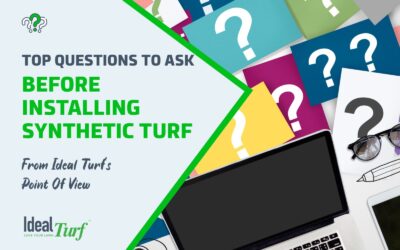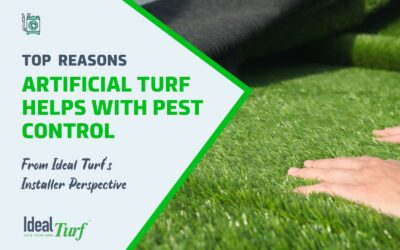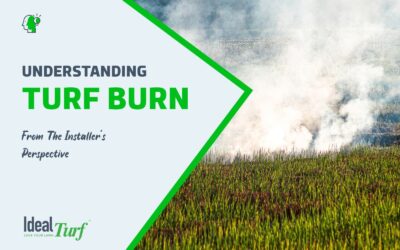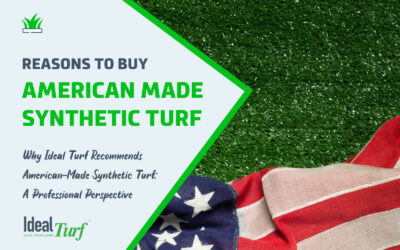How To Choose The Best Artificial Grass For Playgrounds & Children’s Play Areas: A Complete Buying Guide

- How To Choose the Best Artificial Grass for Playgrounds & Play Areas?
- Our Top Picks of the Best Artificial Grass for Playgrounds & Play Areas
- Wrapping Up Our Buying Guide to the Best Artificial Grass for Playgrounds & Children’s Play Areas
Homeowners and park managers alike are tired of wood chips and gravel scattering everywhere beneath playgrounds and play areas.
And kids aren’t thrilled about tumbling down the slide onto hot gravel or splinters.
Surely there must be a better way to provide a safe, shock-absorbant, low-maintenance covering beneath play structures.
Thanks to advances in artificial grass manufacturing technology, there is!
Playground turf doesn’t create the mess of gravel or wood chips, and it provides a softer surface than concrete for rough landings off of the monkey bars.
Whether you’re looking for synthetic turf for your backyard or local park, read on to find out how to choose the best brand, type, and features of artificial grass to go under your jungle gym or playground.

How To Choose the Best Artificial Grass for Playgrounds & Play Areas?
Due to the hassle of maintaining and replenishing other types of playground coverings, artificial grass for playgrounds and play areas has grown in popularity in recent years.
Modern turf products look and feel very similar to the real thing.
Artificial grass looks bright, friendly, and inviting underneath a play structure.
Moreover, it is an eco-friendly alternative to natural grass as it doesn’t require water, fertilizer, or pesticides that are hazardous to children and pets.
This low-maintenance ground cover also improves playground safety by providing a soft cushion for little feet.
Below, we’ll provide a detailed guide about artificial grass for playgrounds to help you weigh your options and find the best fake grass for your playground or play area.

1. Research Artificial Grass for Playgrounds
To the untrained eye, all turf products may look the same: green, fluffy, and grass-like.
However, there is a wide range of durability, features, drainage, and other factors that differentiate the various types of artificial grass.
Not all types of artificial grass will make a base for your playground or play area, so it’s important to choose a variety with the ideal features to provide the best experience.
Doing your research (both online and by asking an expert) will help you hone in on which type will best meet the needs of your play area.
To help with your research, we’ve published several blog posts that you may want to check out.

2. Learn Turf Terminology
Before you go shopping for artificial grass, it’s important to learn the basic vocabulary of artificial turf terminology.
By understanding the specifications of each product, you’ll be confident in your ability to choose the best one for your park, yard, or play area.

Yarn Fibers
The yarn is the material used to make the threads that form the blades of grass.
While the yarn used in artificial grass products can vary in color, thickness, and shape, all yarn is comprised of one of three materials:
- Polyethylene
- Polypropylene
- Nylon
For artificial grass that goes under a playground, you’ll want to steer clear of products made of nylon.
While it’s the most durable of the three, it’s notorious for “turf burns” on skinned knees.
Its harsh texture makes it a poor choice for playgrounds.
It’s also the most expensive.
Polypropylene is the softest of the three materials, but it’s susceptible to matting from wear and tear, which is less than ideal for a spot that is bound to see above-average foot traffic.
When shopping for artificial turf under playgrounds, look for a turf product made with polyethylene yarn.
Besides having the advantage of being an economical choice, polyethylene has the best combination of softness and strength that make it perfect as a park or play area ground cover.

Thatch & Turf Fibers
In a natural grass lawn, there is a layer of dead and dying grass underneath the green, new blades.
This layer is responsible for that cushiony, soft feel we associate with grass under our bare feet.
To simulate this, many modern turf products have a layer of thatch — curly, soft threads that go between the upright green threads — that adds to the realistic aesthetic and cushiony softness of the synthetic grass.
A thick thatch layer is a sign of a high-quality turf product.

Density
A high density is indicative of a durable, high-quality playground turf product.
The artificial grass’s density is how close-knit the fibers are woven together.
A dense product packs more material into each square yard, which means more fibers to absorb friction from foot traffic.

Face Weight
Face weight is the weight of the yarn and thatch and does not include the backing.
High-quality turf products will have a weight of 70 ounces per square yard of material or higher.
Products with face weights lower than this will feel threadbare and not have the durability that playground turf requires.

Pile Height
This measures how tall the artificial grass blades are.
Pile height has more to do with what the turf is used for than how high quality it is.
For places where the artificial grass will be mostly seen and not walked on (such as a front yard), a tall pile height (1.25 inches or more) creates a lush, realistic appearance.
For areas that see heavy use and a lot of foot traffic, it’s better to select a turf with a shorter pile height.
For playground turf, we recommend pile heights of 1.25 inches and below.

Turf Backing
The backing on artificial turf is made up of primary backing (the grid of material that the grass fibers are woven into) and secondary backing (the “fabric” that’s glued on the back and seals everything together).
Together, the primary and secondary backing make up the total back weight.
Well-made artificial grass products that are sturdy enough to go under a play area will have a back weight of above 25 oz. per yard.

Drainage
Though the kids won’t be at the playground on rainy days, your artificial grass will, so it’s vital to select a product with a backing that allows for adequate drainage through the backing.
For most playgrounds and play areas, hole-punched (or perforated) backing is sufficient.
Just like it sounds, hole-punched backing features small holes punched every few inches to allow rainwater to pass through.
Areas prone to standing water or that host pets require 100% permeable backing, which is a more efficient drainage system.

Color
With advances in manufacturing technology, there is now a wide variety of colors of artificial grass.
Turf products are designed to mimic specific species of grass so they match nearby natural lawns and grass areas.
High-quality turf products often have multiple colors of yarn to provide a more realistic look.

Infill Material
The yarn and backing are only part of the artificial grass system.
To complete the installation, nearly all turf requires an infill material (small granules of sand, cork, or other materials) to be spread over the area.
Like soil, the infill is crucial in keeping fibers upright.
It also stabilizes the turf to prevent shifting and buckling.
Infill also makes the playground turf look and feel more realistic.
At Ideal Turf, we use a rounded silica sand infill in our turf installations.

Antimicrobial
Like natural grass, artificial grass can harbor bothersome bacteria, fungus, or mold.
But unlike natural grass, synthetic turf can be manufactured to combat this problem.
Some turf products contain antimicrobial additives that are added during the manufacturing process.
This reduces the microbes (and accompanying odors) that can grow in the turf.
The antimicrobial backing found on Ideal Turf’s artificial grass products called “Microbe-Safe™” helps prevent the buildup of odors from pet urine, as well as germs and bacteria.

UV Protection / UV-Stabilized
Just as you’d put sunscreen on your children to protect their skin from sun damage, high-quality turf products come with built-in “sunscreen” to combat the problems caused by sun exposure.
Look for turf products with built-in resistance to ultraviolet (UV) light.
UV protection keeps artificial grass from fading in the sun and prevents its backing from breaking down and allowing grass fibers to fall out.

3. Compare Features of Playground or Play Area Turf Products
Artificial grass is an ideal ground cover for a variety of areas, from sports fields to pet runs to backyards.
However, synthetic grass is hardly a one-size-fits-all product, and there are now many different products available that are tailored to the many different uses of artificial grass.
Here are the key features to look for when determining which artificial grass product will best suit your playground area.

Quality, Cooling Infill
Artificial grass is made of plastic polymers, so it has a tendency to absorb heat from the sun.
Choosing a high-quality infill with cooling properties will help reduce the surface temperature of the turf by up to 50 degrees, increasing the comfort and safety of the children using the playground turf.

Short Pile Height
While long grass blades add to a lush, full look to a turf installation, they have a greater tendency to matting and flattening.
A short pile height is best for areas, such as playgrounds, that see heavy wear and tear from pitter-pattering feet.
For play areas, choose a pile height of no more than 1.25 inches.

Durability
Few turf installations will see as much abuse as those underneath jungle gyms.
Skimping on the back weight or density of your turf product will be a choice you’ll regret quickly.
Choose a high-quality product that will stand the test of time and children’s feet.
Indicators of a good-quality turf product are a heavy face weight and back weight, a high density, and a lengthy warranty (20 years or longer).

Trustworthy & Reliable Turf Installer
While it’s not part of the playground turf, it’s crucial to choose an experienced, competent artificial grass installation team.
Even the best artificial grass product can look terrible and wear out quickly if the installer doesn’t know what they’re doing.
Check online reviews and get referrals from other clients when investigating an artificial grass installation company.
Turf installers should be willing to answer all your questions about their turf products and their installation process.

4. Costs, Budget & Financing
There are numerous long-term benefits to having artificial grass:
- Lower maintenance costs
- Lower water bill
- Boosted real estate value
- Better curb appeal
While artificial grass has a higher upfront cost than seeding or sodding a regular lawn, the cost savings in lower maintenance and water bills pays for the artificial grass over time.
It usually takes 3-5 years to see an ROI on synthetic turf.
In the meantime, however, you’ll enjoy lush, green, realistic-looking grass beneath your playground without worrying about how to maneuver a lawnmower or weed eater around a slide or teeter-totter.
If it’s not in your budget to pay for the entire artificial grass installation, check with your turf installer to see if they offer financing options.

How Much Does Artificial Grass for Playgrounds Cost?
Naturally, the cost will depend on how large of a play area you want to cover with artificial grass.
It also varies based on the layout of the playground and whether the play structure is already installed or will be added afterward.
You can get a rough idea of the cost by calculating the square footage of the area and considering the materials and labor required.
However, installing turf beneath an existing play structure can be challenging due to the number of seams involved, so it’s best to consult a professional for an accurate quote.

5. Weigh The Pros & Cons of Fake Grass for Playgrounds & Play Areas
Not every playground is well-suited for fake grass, and there are definite pros and cons to having synthetic turf beneath your play structure.
Here’s the breakdown of some of the pluses and minuses about having artificial grass under your play area.
| PROS | CONS |
|---|---|
| Less effort to maintain | Heat absorption |
| Less costly to maintain | High installation cost |
| Green and beautiful year-round | |
| Less messy (no scattered gravel/mud) | |
| Better cushion for falls | |
| No holes or bare spots | |
| Hypoallergenic | |
| Less bacteria/mold/fungus |

6. Safety & Playground Fall Zone Requirements
The following applies primarily to commercial playground turf installations, but should also be considered for residential play areas.
If there is any equipment on the playground the turf and cushion material has to be fall height (zone) rated.
The IPMEA has standards and there is an ASTM test as well.
The fall zone is the area that surrounds slides, swings or climbing equipment where playground surfacing must be installed to prevent injury.
According to the U.S. Consumer Product Safety Commission (CPSC), the fall zone’s surfacing must extend beyond the equipment for a minimum of six feet.
Fall-related injuries on swings and slides are especially common.
To meet fall zone requirements, surfacing in front of a slide’s exit should extend four feet plus the height of the slide, with a minimum of six feet and a maximum of 14 feet.
Swings must be surrounded by surfacing that is two times the length of the pivot point to the surface, both to the front and back of the swing.

What is Critical Fall Height?
Surrounding equipment in protective surfacing is not enough to improve safety.
The surfacing must also be thick and deep enough to absorb impact based on its critical fall height.
The critical fall height of a playground surface is the fall height below which a life-threatening head injury would be unlikely to occur.
A surface is tested in a lab or at a playground site for its impact attenuation, or shock-absorbing properties.
The critical fall height is then determined by combining the acceleration of an impact with the duration of the impact, specifically related to head injuries.
If you’re installing surfacing within a fall zone, consider the critical fall height of and required depth for each material.
Speak with one of our turf installation experts to ensure that the artificial grass and foam padding you install meet playground fall height requirements.

Our Top Picks of the Best Artificial Grass for Playgrounds & Play Areas
While there are several turf products that will work well as the best artificial grass for playgrounds and play areas, we thought we’d share two of our very favorites with you.
These products are high quality and perfect for installation under a playground or play area.

Aberdeen 84
The deep green of the Aberdeen 84 artificial grass is sure to look striking beneath your playground or backyard children’s play area.
Its ample thatch layer will help the grass resist trampling and matting and provide a heavenly cushion to bare feet.
It features a generous 20-year manufacturer’s warranty as well as DUAL FLOW backing and antimicrobial additives to prevent the formation of bacteria, mold, and fungus.

Dundee 77
Dundee 77’s shorter pile height of 1 inch will give running feet a good, grippy surface to walk on around the playground.
It will also resist flattening and matting.
The vibrant green color and plentiful thatch layer make it extremely realistic and an excellent choice to go under playgrounds.
Dundee 77 also features the DUAL FLOW backing with antimicrobial properties that are ideal for a playground installation.
It is made in the USA and backed by a 20-year warranty.

Wrapping Up Our Buying Guide to the Best Artificial Grass for Playgrounds & Children’s Play Areas
If you’re ready to abandon the tedious chore of raking gravel or wood chips back into the playground, check out artificial turf for your play area.
It’s less messy and less maintenance than other playground ground cover materials, and it provides a safe cushion for any tumbling feet, knees, or hands.
What’s more — you’ll enjoy the beauty of lush, green grass (without any bare spots or divots) all year round with almost no maintenance.
If you’re ready to install artificial grass under your playground or play area in Texas or Oklahoma, please contact the experts at Ideal Turf today!
We can give you an accurate, free quote for your play area and answer any questions you might have about turf products, features, and the installation process.
Get your FREE artificial grass design & installation estimate by clicking the “GET A QUOTE” button or feel free to give us a call at 800-204-4650.
Author: Tim Taylor
Recent Posts
- How Synthetic Turf Helps Keep Fleas and Ticks Out of Your Texas and Oklahoma Yard
- Porches, Patios & Personality: Creating Outdoor Spaces Texans Love
- Turn Your Backyard into a Golfer’s Dream: Custom Putting Greens by Ideal Turf
- Why Texas Pet Owners Are Choosing Pet-Friendly Artificial Grass from Ideal Turf
- Why More Texans and Oklahomans Are Turning to Artificial Grass for a Greener Future






